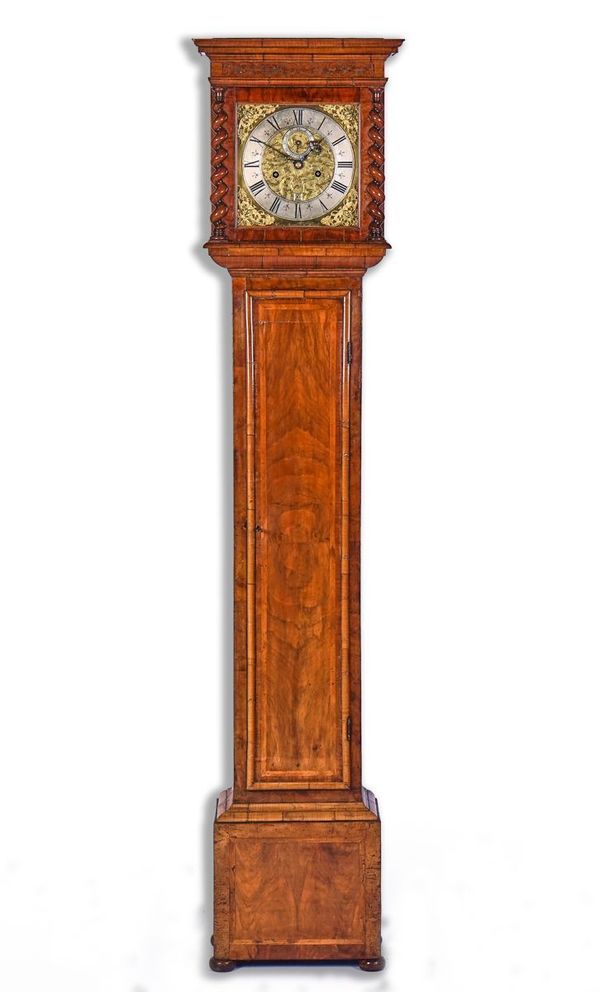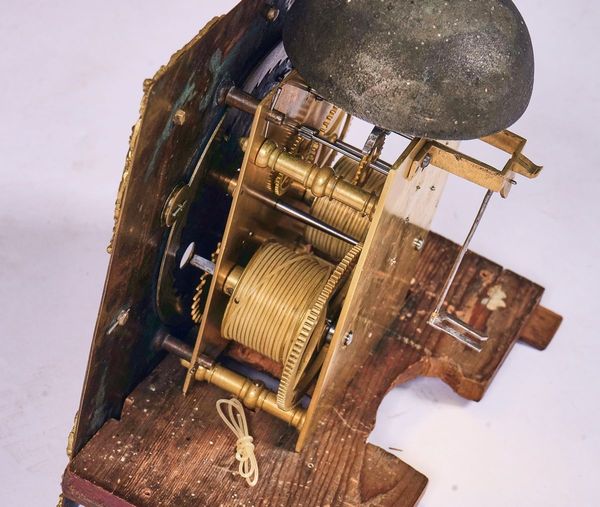WILL COLLECT. SC SPOKE 25.2.22. AN INTERESTING WALNUT AND FEATHER-BANDED LONGCASE CLOCK
The 10in. dial inscribed Henry Jones in ye Temple
| Estimate: | £3,000 - £5,000 |
The case: with rising hood, moulded pediment above a pierced sound fret, the square glazed dial aperture flanked to each side by a Solomonic handed column and with a quarter-column to the back, above the trunk inset with a panel door, above plain plinth and bun feet, 191cm high
The movement: twin train, four latched pillars with conical terminals to the front, internal countwheel strike, anchor escapement and deeply cut slot to the backplate for the crutch; bolt and shutter work now missing
The dial: 10in. square, later inscribed Henry Jones in ye Temple, the matted centre engraved with three birds amidst foliage, cherub and foliate masks, silvered chapter ring and seconds subsidiary with date aperture above the VI
PROVENANCE: The Sneyers Family, The Refectory, Milford, Godalming.
By descent to the National Trust, sold Sotheby's, 27 and 28 June 1988, lot 220.
Purchased at the above sale by the deceased, now sold on behalf of his executors.
Most interestingly, it has been suggested that the movement could possibly be attributed to John Fromanteel, who worked with Salomon Coster. The use of four latched pillars, where the turning is not precisely finished, is a characteristic of his work.
Condition report
The case: It appears to have a good deal of reconstruction. Most likely its genesis was an old case which has been reduced and reveneered. The backboard runs the full length, with a light waterstain at the base, however there a couple of very strangely placed ‘holes’ for fixing to a wall. The inner edge moulding to the trunk door opening has a chamfer which does not run as one piece all the way through, but has been cleverly worked in with what appears to be three pieces to each side. The door edge has a painted dark grey stain surface painted to it. The lower cleat is slightly loose from the door panel and one can see a clean surface in the join. The door seems a replacement, good internal colour on the inner side but the edges have a raised grain. The ends of each oak side piece are clearly a modern cut.
The movement: With the dial off, the pillars have a high rocket shape cone to the ends. Maintaining power is now removed but could be re-instated. The barrel squares have been later cut with a cross. Signs of wheel scribing on front plate dial side.
The dial - Signature does not look convincing and suspect is 20th C. Overall the dial plate is quite thin, and reduces to the top. I imagine it is old. On the underside the chapter ring scribe is very tight and fractionally lost to the edges, so likely it is reduced from a larger plate. The scribe gives a diameter of 255mm whereas the outer diameter of the ring dial side is 228mm. An 11in ring would be about 55mm across the edge so would cover from the edge of the engraved centre to the outer edge as it is now. Centre is engraved appears to be period, differences to the engraving around winding apertures, below seconds ring is some engraving, the bird’s head to the left but some areas plain, not engraved or matted. Possibly the chapter ring and therefore the seconds ring are replaced.
Lastly, the date ring numerals are somewhat larger than expected quite large and a little wheel (of three) which holds and supports the date ring has a very slight ‘show’ at the base of the aperture. Two brass-cased weights, one pendulum




